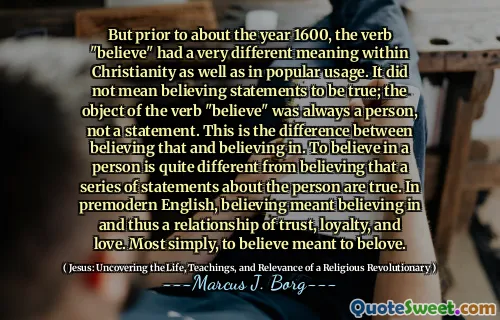
But prior to about the year 1600, the verb "believe" had a very different meaning within Christianity as well as in popular usage. It did not mean believing statements to be true; the object of the verb "believe" was always a person, not a statement. This is the difference between believing that and believing in. To believe in a person is quite different from believing that a series of statements about the person are true. In premodern English, believing meant believing in and thus a relationship of trust, loyalty, and love. Most simply, to believe meant to belove.
This quote highlights a profound shift in the understanding of the word "believe," emphasizing a distinction that is often overlooked in modern discourse. In contemporary usage, believing is primarily associated with cognitive assent to factual statements or propositions — believing that something is true. However, the historical use of "believe" had a relational and deeply personal connotation: to believe in someone was to place trust, loyalty, and love in that person.
This distinction opens an enriching perspective on faith, especially within the context of Christianity, as the quote originates from. Faith in such a context should be viewed not merely as intellectual acceptance or agreement with doctrinal points but as an intimate and trusting relationship with a person — Jesus Christ. The idea of believing as "beloving" suggests an engagement of the whole self, implicating emotions, commitment, and active trust rather than a passive acknowledgment of facts.
Reflecting on this, the word "believe" beckons us to reconsider how faith and trust function in human experience and spirituality. It challenges the often rigid, fact-based conception of belief prevalent in modern societies. Instead, it invites recognition of belief as fundamentally relational. This shift can reshape religious dialogue, personal faith journeys, and even broader social interactions, where to believe in someone or something involves connection, care, and personal investment, which transcends mere intellectual agreement.
Ultimately, understanding 'believe' as 'belove' encourages a more profound appreciation for the depth of faith and trust, emphasizing that true belief is more about relationship and love than simple cognitive assent.







